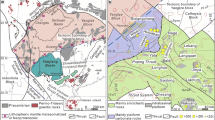Abstract.
Gold exploration in China has expanded rapidly during the last two decades since a modern approach to economic development has become a national priority. China currently produces 180 tonnes (t) of gold annually, which is still significantly less than South Africa, USA, and Australia. However, China is now recognized as possessing significant gold resources in a wide range of mineral deposit types. Present estimates of gold resources in China exceed 4,500 t, which comprise 60% in gold-only deposits, more than 25% in base metal-rich skarn, porphyry, and vein deposits, and more than 10% in placer accumulations. The major gold provinces in China formed during the main episodes of Phanerozoic tectonism. Such tectonism involved interaction of China's three major Precambrian cratons, North China, Tarim, and Yangtze (or South China when combined with Cathaysia block), with the Angara (or Siberian), Kazakhstan–Kyrgyzstan, and Indian cratons. Resulting collisions included deformation of accreted oceanic sequences between the cratonic blocks. The most important ore-forming orogenies were (1) the late Paleozoic Variscan (405–270 Ma), which led to amalgamation of the Angara, North China and Yangtze cratons, (2) the Indosinian (270–208 Ma), which led to the collision of North China and South China cratons, (3) the Yanshanian (208–90 Ma), which was largely influenced by the subduction of the Izanagi–Pacific plates beneath eastern China, and (4) the Himalayan (<90 Ma) indentation of the Indian continent into Eurasia. No important Precambrian gold systems are recognized in China, mainly because of reworking of exposed Precambrian rocks by these younger orogenies, but there are a few Caledonian (600–405 Ma) gold-bearing systems in northern Xinjiang. Most of China's orogenic, epithermal, and Carlin-like gold deposits are in the reworked margins of major cratonic blocks and in metasedimentary rock-dominated fold belts adjacent to these margins. Accordingly, the major gold provinces are present along the northern, southeastern and southern margins of the North China craton, along the southwestern and northwestern margins of the Yangtze craton, in the Tianshan and Altayshan orogenic belts in northern Xinjiang, and throughout the southeastern China fold belt. Gold-placer deposits derived from these primary deposits are concentrated in the northernmost part of northeastern China and along the northwestern margin of the Yangtze craton. The major provinces with significant gold in porphyry-related copper systems and base metal skarns are present in the Yangtze River area along the northeastern and southeastern margin of the Yangtze craton, in the fold belt in southwestern China, and scattered through northern China. Three-quarters of the Chinese gold-only deposits occur within the North China craton margins. Half are located in the uplifted Precambrian metamorphic rocks and most of the remainder are hosted in the Phanerozoic granitoids that intruded the reworked Precambrian terranes. The abundance of granite-hosted gold contrasts the North China craton with other Precambrian cratons, such as those in Western Australia, central Canada, and Zimbabwe, where gold is mainly hosted in the Archean greenstone belts. This difference may be explained by the multiple episodes of Phanerozoic tectonism along the North China craton margins resulting from the collision of the Angara, North China, and South China cratons, and from subduction of the Izanagi–Pacific oceanic plates underneath the eastern China continent.
Similar content being viewed by others
Author information
Authors and Affiliations
Additional information
Electronic Publication
Rights and permissions
About this article
Cite this article
Zhou, T., Goldfarb, R.J. & Phillips, N.G. Tectonics and distribution of gold deposits in China – an overview. Min Dep 37, 249–282 (2002). https://doi.org/10.1007/s00126-001-0237-4
Received:
Accepted:
Issue Date:
DOI: https://doi.org/10.1007/s00126-001-0237-4




